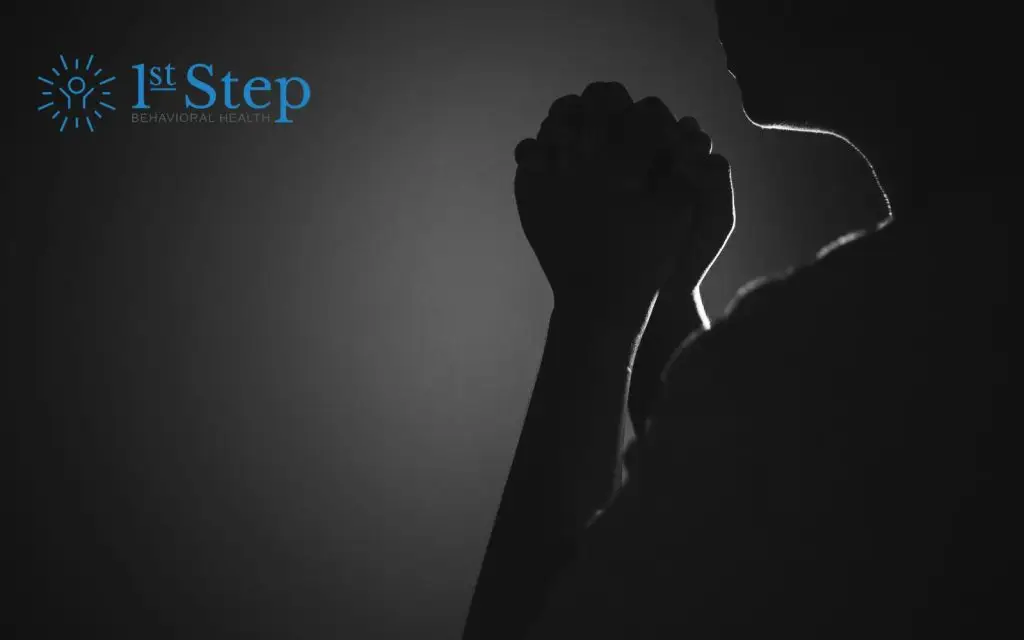In the world of addiction recovery, certain moments mark turning points—not just of behavior, but of mindset and spirit. The AA Third Step Prayer, embedded deep within the fabric of Alcoholics Anonymous (AA) and other 12-step programs, is one such moment. It’s not just a passage from the Big Book or a quiet recitation at AA meetings. It’s a profound declaration of surrender—offering one’s will and life to a higher power in pursuit of transformation and healing.
This article unpacks the Third Step Prayer and how it may benefit people in addiction recovery. We’ll explore its meaning, impact, and psychological resonance. You will also learn how spirituality may fit into comprehensive inpatient or outpatient addiction treatment programs and long-term recovery.
What Is the Third Step Prayer?
The Third Step Prayer, from the Big Book of Alcoholics Anonymous, is as follows:
“God, I offer myself to Thee—to build with me and to do with me as Thou wilt. Relieve me of the bondage of self, that I may better do Thy will. Take away my difficulties, that victory over them may bear witness to those I would help of Thy Power, Thy Love, and Thy Way of Life. May I do Thy will always!”
This prayer is typically introduced in Step 3 of the 12-step program. It’s a request for guidance—a release of self-will. A moment of humility occurs when the person in recovery acknowledges that trying to control life through willpower alone has not worked, and they decide to trust in something greater.
Why the Third Step Prayer Matters in Recovery
The essence of Step 3 and its prayer is surrender. However, this isn’t the passive surrender of defeat. Instead, it’s an active surrender of ego–a willingness to let go of controlling everything, and to allow recovery to unfold through faith, intention, and the help of a higher power.
Recovery is not just abstaining from substances. It’s an overhaul of thinking, relating, and being in the world. The AA Third Step Prayer anchors this process. It is an invitation to walk a new way of life–one that is not governed by wishful thinking or compulsion.
This prayer is especially powerful for those struggling with addiction. Addiction often thrives on isolation, shame, and control. Saying this prayer is a bold step toward connection, acceptance, and surrender.
What Role Does God or a Higher Power Play in Recovery?
The idea of turning one’s life over to a higher power can feel daunting or off-putting for some. However, the AA Book is intentionally inclusive. It states: “God as we understood Him.”
That understanding is flexible. Some see God in a traditional sense. Others understand the higher power as nature, community, love, or simply the recovery process itself. The essential point is that recovery is not a solo mission.
The step prayer god language is a connection to something greater than your own fear, pain, and self-will. That connection becomes a guiding force, shaping how decisions are made and how difficulties are handled.
The Psychology Behind the Prayer
Modern psychology aligns with many ideas embedded in the prayer. For instance, cognitive-behavioral therapy (CBT) models recognize that over-control and rigid thinking patterns perpetuate anxiety and compulsive behaviors. Surrender can be a reset—an emotional and mental shift that fosters acceptance and reduces reactivity.
Research also suggests that daily commitment can help people maintain their recoveries. Many in recovery make the prayer part of their daily life. Like mindfulness, its repetition builds a mindset of groundedness and presence.
Saying the prayer daily may also increase resilience during recovery. According to a 2020 study published in the Journal of Substance Abuse Treatment, spiritual practices—including prayer—correlate with greater emotional resilience and reduced relapse rates.
Daily use of the prayer may help people develop a different, more helpful perspective of their recoveries. Praying “I offer myself to thee” and “take away my difficulties” isn’t magical thinking. It’s a form of intentional reframing, which neuroscience suggests can alter brain patterns and improve mental health over time.
Statistics That Underscore the Importance of a Spiritual Approach
According to SAMHSA (2023), approximately 46.3 million Americans aged 12 or older had a substance use disorder in the past year. The National Institute on Drug Abuse (NIDA) reports that individuals who engage in a recovery program that incorporates spiritual principles show higher long-term success rates.
One longitudinal study found that those involved in 12-step programs were twice as likely to maintain abstinence over two years compared to those who didn’t engage in such programs. A 2021 study by Pew Research found that over 76% of Americans believe in a higher power or spiritual force, supporting the idea that spiritual language, such as that in the 3rd step prayer, resonates deeply with many.
Spirituality and surrender aren’t just buzzwords. They are research-backed ways of committing to sobriety and maintaining it for life.
Saying the Prayer: More Than Words
The third step isn’t just about reciting the prayer. It’s about making a decision. It’s about integrating the words into daily life—living with the willingness to be led rather than always trying to lead.
When someone prays, “Take away my difficulties, that victory over them may bear witness,” they’re not asking to be spared hardship. They’re asking for the ability to rise above those difficulties in a way that inspires and supports others. They want to transform and embrace the power, love, and possibility that recovery brings.
From Prayer to Practice: Daily Integration
For many in recovery, the Prayer becomes a cornerstone of correct thought and positive action. Here are ways it gets integrated into life:
- Morning ritual: Saying the prayer first thing, grounding the day in intention and humility.
- During crises: Repeating it when urges or emotional turbulence hit.
- Before service: Many say it before speaking at AA meetings or when supporting others in their recovery journey.
- Written reflections: Journaling around these phrases helps unpack their meaning on a personal level.
- Sponsors and sponsees: Often, sponsors and their sponsees will discuss the prayer and Step 3 in depth during their work together.
The Prayer isn’t a magic wand. It’s not about instant change or flawless execution. It’s about alignment—choosing again and again to seek guidance, to let go of control, to walk a path that isn’t ruled by ego, compulsion, or fear.
Final Thoughts: The Quiet Power of Step Three
For anyone walking this road or their supporters, the Third Step Prayer is more than poetry. It’s a tool with the power to create a new beginning.
Recovery may be long. It may be painful. But with faith, surrender, and willingness, each step becomes lighter.
Spirituality is an important aspect of comprehensive addiction treatment. Treatment may include medical care, detox services, addiction counseling, and other evidence-based therapies. Find the treatment, support, and recovery resources you need at First Step Behavioral Health. Contact our intake team to explore your treatment options or to schedule your first appointment.
FAQ: Understanding the Third Step Prayer in Recovery
1. Is the Third Step Prayer only used in Alcoholics Anonymous?
While rooted in Alcoholics Anonymous, the Third Step Prayer is embraced in other 12-step programs like Narcotics Anonymous, Overeaters Anonymous, and Al-Anon. Its universal themes—surrender, trust, and seeking guidance—make it adaptable to various forms of recovery, regardless of the specific addiction or behavior being addressed.
2. What if I don’t believe in God or identify as an atheist or agnostic?
Belief in a traditional deity is not required. The phrase “God as we understood Him” invites personal interpretation. Many people in recovery substitute the term “Higher Power” with concepts such as the universe, collective wisdom, love, nature, or even the fellowship itself. The key is identifying something greater than oneself that can guide and support the healing process.
3. Can the Third Step Prayer be customized for personal use?
Yes. Many individuals personalize the wording to reflect their beliefs or experiences better while maintaining the core intention: surrendering self-will and seeking guidance. Some replace archaic language (e.g., “Thy” or “Thee”) with modern equivalents, while others rephrase specific phrases to align with their spiritual worldview.
4. When should someone start using the Third Step Prayer in recovery?
Typically, it’s introduced during Step 3, but individuals may begin using it earlier if they feel ready to explore the ideas of surrender and spiritual connection. Sponsors often guide newcomers through this process to ensure it’s meaningful and not just ritualistic.
5. How does the Third Step Prayer help with relapse prevention?
The prayer fosters humility, accountability, and perspective—all of which are protective against relapse. By actively inviting guidance and releasing the need to control every outcome, individuals reduce the emotional and mental strain that often precedes a relapse. It also reinforces connection to a support system and a larger recovery framework.
6. Is the Third Step Prayer meant to be said daily, or only once?
While it’s officially part of Step 3, many use it as a daily affirmation or grounding ritual. Repetition strengthens its impact, helping individuals stay aligned with their recovery goals and maintain emotional balance throughout the ups and downs of daily life.
Sources:
- Alcoholics Anonymous, The Big Book, Step 3
- National Institute on Drug Abuse (NIDA) Substance Use Statistics, 2022
- Substance Abuse and Mental Health Services Administration (SAMHSA), 2023 Report
- Pew Research Center, American Spirituality Survey, 2021
- Journal of Substance Abuse Treatment, “Spirituality and Recovery Outcomes,” 2020
Jump to a Section
Call (855) 425-4846
